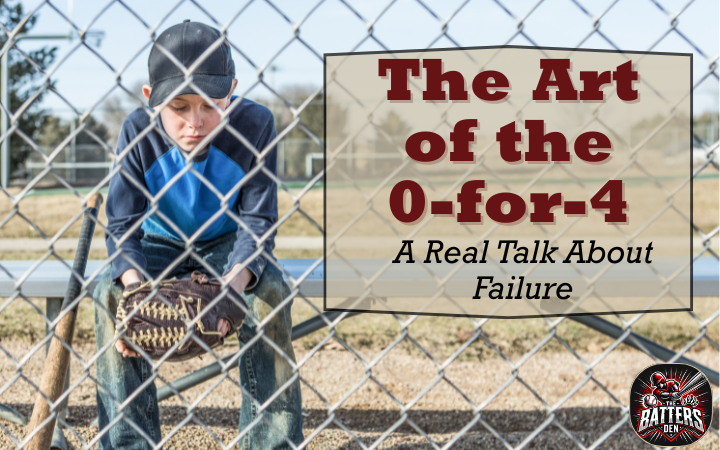
We talk a lot about success here. We focus on the reps, the results, the roar of the crowd, and the feeling of squaring up a ball perfectly. But today, we’re not talking about that.
Today, let’s talk about the other side. Let’s talk about striking out with the bases loaded. Let’s talk about the error that costs your team the game. Let’s talk about the long, quiet car ride home after seeing your name wasn’t on the final roster.
Let’s talk about failure.
And before we go any further, let’s get one thing straight: It sucks. It’s a punch to the gut. It’s supposed to hurt. If it didn’t, it would mean you don’t care. This article isn’t about pretending that feeling doesn’t exist. It’s about what you do in the moments, hours, and days after you feel it. It’s about turning the sting of failure into the fuel for your success.
Welcome to the Club (Baseball is a Game of Failure)
There’s a well-known fact in baseball that we need to stop treating as a simple piece of trivia and start treating as the Golden Rule: A player who gets a hit just three out of every ten times is considered an All-Star. A player who can do it four out of ten times is a legend spoken of in whispers.
Think about that. Our sport is fundamentally designed for you to fail, constantly. It’s not an accident; it’s the entire architecture of the game. Because of this, learning to manage your reaction to failure is the single most important mental skill you can develop. It is more valuable than your exit velocity or your arm strength because it’s the skill that allows all your other skills to function when things go wrong.
The Process: How to Fail Well (The Nitty-Gritty)
So, if failure is inevitable, how do we get better at it? You need a process. Here is a simple, four-step framework for handling failure like a pro.
Step 1: The Dugout Rule
Give yourself permission to be angry. You are a competitor, and you should be frustrated when you don’t succeed. But you must give that frustration a time limit. We call it “The Dugout Rule.” You have from the moment you fail (the third strike, the booted ground ball) until your cleats hit the dugout floor to feel the sting. Be mad. Clench your fists. Replay it in your head. But the moment you sit on that bench, that part is over. Your focus shifts immediately to your team and the next play.
Step 2: Separate the “Did” from the “Am”
This is the most crucial mental shift you can make. Striking out is something you did; it is not who you are. Making an error is an event; it does not make you a bad ballplayer. The best athletes in the world have a short memory. They are able to separate a single bad outcome from their overall identity as a skilled, confident player. You must learn to do the same.
Step 3: Find the Data
Once the initial emotion has passed, you have to get analytical. Failure is not a verdict; it is information. It is data. Why did you fail? Be brutally honest with yourself. Were you late on a fastball? Did you chase a curveball in the dirt? Did you rush your throw because you weren’t set? The sting of failure sharpens your focus. Use that focus to diagnose the problem without emotion.
Step 4: Make a Plan
The only true antidote to the feeling of failure is productive action. Once you have the data (“I keep chasing high fastballs”), you can create a plan (“My next cage session at The Den, I’m setting the machine two inches higher than normal and my only goal is to track the ball and not swing.”). This process turns the helplessness of failure into the empowerment of a plan. You now have a mission.
The Attitude Check (What Failure is NEVER an Excuse For)
Let’s be clear: feeling the sting of failure is acceptable. Throwing a tantrum is not. The moment you fail is a direct test of your character, and your coaches are watching.
Failure is not an excuse to throw your helmet or slam your bat. Failure is not an excuse to blame the umpire, a teammate, or the field conditions. Failure is not an excuse to pout on the bench and bring negative energy to your team.
When you do any of those things, you are proving you haven’t learned Step 2. You are making the failure about your ego instead of the team’s mission to win the game. It’s a sign of mental weakness, and it is a massive red flag for every coach, at every level.
The Cage is Your Laboratory for Failure
This is where all this talk comes home to The Batter’s Den. We are not just a place to practice success; we are a safe place to fail.
The cage is where you can, and should, be failing over and over again. It’s where you can try that new stance and feel awkward. It’s where you can be late on the high-velocity machine 50 times in a row to find a timing adjustment. It’s where you can experiment, tinker, and struggle without the pressure of a live game. Failing in the cage is not just okay—it’s the entire point.
At The Batter’s Den, our goal isn’t just to help you build a perfect swing, but to help you build a resilient mindset. The work you do here isn’t just about preparing for that moment of glory; it’s about giving you the strength and the plan to persevere through the hundreds of moments of failure it takes to get there. Learning how to fail well is the true secret to a long and successful career in this game.

